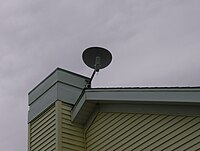|
Cambium Networks
Cambium Networks Corporation is a wireless infrastructure provider that offers fixed wireless and Wi-Fi to broadband service providers and enterprises to provide Internet access. An American telecommunications infrastructure company, it provides wireless technology, including Enterprise WiFi, switching solutions, Internet of Things, and fixed wireless broadband and Wi-Fi for enterprises.[6][7][8] Publicly traded on the NASDAQ stock exchange, it spun out of Motorola in October 2011.[9][10][11] ProductsCambium Networks manufactures point-to-point backhaul, point-to-multipoint communication wide area network (WAN), Wi-Fi indoor and outdoor access, and cloud-based network management systems.[12] In 2020, the company collaborated with Facebook to add mesh networking technology Terragraph that allows high-speed internet connections where laying fiber optic cable is not viable.[13] As of 2021 the company has shipped 10 million radios.[14] Products are available in point-to-point and point-to-multipoint configurations. Its cnWave fixed wireless solution provides multi-gigabit throughputs.[14] It includes both the original Motorola-designed products using the Canopy protocol and the PtP backhauls that were rebranded from Orthogon Systems, which Motorola acquired in 2006. Cambium Networks’ solutions are used by broadband service providers and managed service providers to connect business and residential locations in dense urban, suburban, rural and remote locations, including education and healthcare.[15] Campgrounds, RV parks and holiday parks have deployed Cambium Networks' fixed wireless and Wi-Fi for high-speed connectivity.[16] Enterprise Wi-Fi and SwitchingCambium Networks also manufactures Wireless LAN (WLAN) Wi-Fi access points including Wi-Fi 6E and intelligent switches along with cloud-management systems.[17] In 2022, Spectralink added interoperability with Cambium Networks access points and Wi-Fi phones and handsets as part of its enterprise wireless certification program.[18] HistoryCambium Networks was created when Motorola Solutions sold the Canopy and Orthogon businesses in 2011. Cambium evolved the platform and expanded it to three product lines: Point to Point (PTP) (formerly Orthogon), Point to Multipoint (PMP) (formerly Canopy) and ePMP.[19] In July 2019, Cambium acquired Xirrus from Riverbed Technology.[20] In June 2019, the company listed on the NASDAQ Stock Exchange in an initial public offering that raised $70 million.[21] WISPA network operator members voted Cambium Networks the “Manufacturer of the Year” from 2017-2020.[14] The technology competes with WiMAX, LTE and other long range mobile products, but not effectively with wired Internet, which is capable of much faster speeds and does not have wireless relay round-trip delay. Competent Canopy implementations such as the Broadband for Rural Nova Scotia initiative however have demonstrated VoIP, gaming and other low-latency applications work acceptably over this system, and in areas of challenging weather including high wind conditions (which cause antennas to move and affect connections). Typical setup  A typical Canopy setup consists of a cluster of up to six co-located standard access points (AP), each with a 60 degree horizontal beamwidth antenna, to achieve 360 degree coverage. The most commonly used APs are available in 120, 180, or 360 degree models for site-based coverage, thus decreasing the number of APs needed on a tower. Also included would be one or more backhauls or otherwise out-of-band links (to carry data to/from other network occasions) and a Cluster Management Module (CMM) to provide power and synchronization to each Canopy AP or Backhaul Module (BM). Customers of the system receive service through subscriber modules (SM) aimed towards the AP. The SMs should be mounted on the highest point of a building to get a reliable connection; otherwise, Fresnel zone obstruction will weaken the signal. Under ideal operating conditions, the system can communicate over distances of 3.5 to 15 miles (5.6 to 24.1 km) depending on the frequency using equipment with integrated antennas. Network operators can opt to install reflector dishes or Stinger antennas or to use Canopy models that accept external antennas at one or both ends of the link to increase coverage distance. Most Canopy equipment receives its power using Power over Ethernet, however, none of its standards comply with IEEE 802.3af. A customer can query the status of their SM by viewing URL 169.254.1.1/main.cgi with a web browser (unless the network operator uses a different IP address or has put the subscriber in a VLAN. In general, the 900 MHz version is more effective for use in outlying areas because of its ability to penetrate trees.[22] However, it requires careful installation because of the easy propagation of interference on that band. Other frequencies currently available are 2.4 GHz, 5.2 GHz, 5.4 GHz, and 5.7 GHz. Comparison with other wireless networking systemsWhile Cambium offers products that support the Wi-Fi protocols (mostly the cnPilot range and the products from their Xirrus acquisition), most of their outdoor, long-range products function exclusively with the proprietary TDMA Canopy or Cambium protocols on custom FPGA code. These are heavily optimized for GPS synchronization, frequency re-use, low latency and long distances / high interference survival.[23] The versions of this protocol include:
These products are fixed wireless technology. Canopy protocol products have many advantages over Wi-Fi and other wireless local area network protocols:
Their main disadvantages are:
See alsoReferences
External links
|
||||||||||||||||||||||||||
